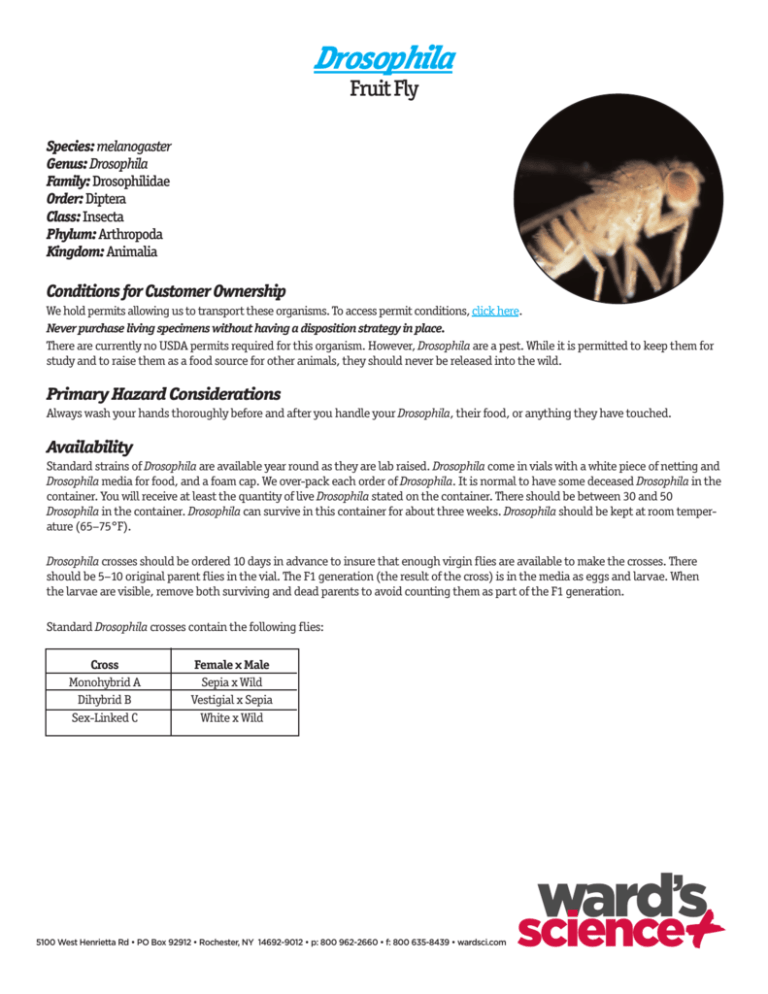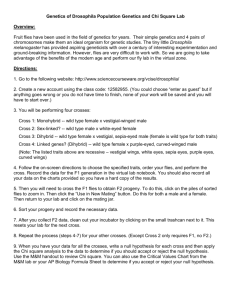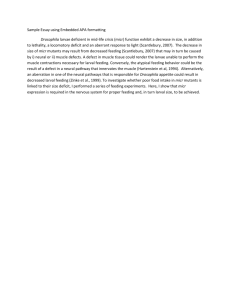
Drosophila
Fruit Fly
Species: melanogaster
Genus: Drosophila
Family: Drosophilidae
Order: Diptera
Class: Insecta
Phylum: Arthropoda
Kingdom: Animalia
Conditions for Customer Ownership
We hold permits allowing us to transport these organisms. To access permit conditions, click here.
Never purchase living specimens without having a disposition strategy in place.
There are currently no USDA permits required for this organism. However, Drosophila are a pest. While it is permitted to keep them for
study and to raise them as a food source for other animals, they should never be released into the wild.
Primary Hazard Considerations
Always wash your hands thoroughly before and after you handle your Drosophila, their food, or anything they have touched.
Availability
Standard strains of Drosophila are available year round as they are lab raised. Drosophila come in vials with a white piece of netting and
Drosophila media for food, and a foam cap. We over-pack each order of Drosophila. It is normal to have some deceased Drosophila in the
container. You will receive at least the quantity of live Drosophila stated on the container. There should be between 30 and 50
Drosophila in the container. Drosophila can survive in this container for about three weeks. Drosophila should be kept at room temperature (65–75°F).
Drosophila crosses should be ordered 10 days in advance to insure that enough virgin flies are available to make the crosses. There
should be 5–10 original parent flies in the vial. The F1 generation (the result of the cross) is in the media as eggs and larvae. When
the larvae are visible, remove both surviving and dead parents to avoid counting them as part of the F1 generation.
Standard Drosophila crosses contain the following flies:
Cross
Monohybrid A
Dihybrid B
Sex-Linked C
Female x Male
Sepia x Wild
Vestigial x Sepia
White x Wild
8FTU )FOSJFUUB 3E t 10 #PY t 3PDIFTUFS /: t Q t G t XBSETDJDPN
Name
Description/Characteristics/Notes
Drosophila melanogaster,
Wild type (+)
Normal characteristics (red eyes and normal wing size).
Drosophila mojavensis
Long life cycle (approximately one month).Useful for comparative population studies and
for preparing salivary gland chromosome squashes.
Drosophila virilis
One of the largest Drosophila species. Useful for preparing salivary gland chromosome squashes.
Chromosome I Mutants (Sex-Linked)
Apricot (a)
Apricot eyes, males’ eyes slightly larger than females’.
Bar (B)
Bar eyes (narrow vertical bar), males’ eyes larger than females’.
Forked (f)
Forked bristles.
Miniature (m)
Miniature wings (slightly longer than abdomen, but with normal proportions);
dark gray and less transparent than normal.
Ruby (b)
Clear ruby eyes.
Vermilion (v)
Vermilion (bright red) eyes.
White (w)
White eyes.
White-Crossveinless-Forked
(w; cv; f)
White eyes, crossveinless wings, forked bristles.
White-Miniature-Forked
(w; m; f)
White eyes, miniature wings, forked bristles.
Yellow (y)
Lightest body color.
Yellow-Forked-Attached,
and White (yf:=&w[1])
Females: normal eyes, yellow body with forked bristles, normal wings.
Males: white eyes, gray body, normal wings.
Note: Remove culture from stock when all females have died or when all flies have white eyes.
Yellow-White (y;w)
Lightest body color, white eyes.
Yellow-White-Miniature
(y;w; m)
Lightest body color, white eyes, miniature wings.
Chromosome II Mutants
Apterous (ap)
Wingless (lacking all wing blade structures).
Black (b)
Black body (darker at cooler temperatures).
Black-Purple-Curved (b;pr;c)
Black body, purple eyes (ruby upon emergence, darken to purple with age), curved wings.
Black-Vestigial (b;vg)
Black body, vestigial wings.
Brown (bw)
Brown eyes (light brown/wine upon emergence, darken to garnet with age). Produces white eyes
when crossed with vermilion, cinnabar, or scarlet.
Cinnabar (cn)
Cinnabar eyes (slightly brighter than wild, dull with age).
Dumpy (dp)
Truncated wings (approximately half normal length).
8FTU )FOSJFUUB 3E t 10 #PY t 3PDIFTUFS /: t Q t G t XBSETDJDPN
Chromosome II Mutants (continued)
Heldout (ho)
Wings extended at right angles to body.
Lobe (L)
Lobe-shaped eyes (slightly reduced size with a nick in anterior edge;
lower half reduced more than upper half).
Star-Curly (S;Cy)
Eyes rough, slight smaller and narrower than wild type. Wings curved upward.
Vestigial (vg)
Vestigial wings (increase in size at 29°C or higher).
Vestigial-Brown (vg;bw)
Vestigial wings, brown eyes (darken with age).
Chromosome III Mutants
Antennapedia (Antp)
Legs grow in place of antennae.
Ebony (e)
Shiny black body.
Scarlet (st)
Scarlet (eyes bright vermilion; darken with age).
Sepia (se)
Sepia eyes (brown at emergence, darken to sepia, become black with age).
Sepia-Ebony (se;e)
Sepia eyes, shiny black body.
Chromosome IV Mutants
Eyeless (ey)
Eyes half to one-quarter normal size.
Polished (pol)
Eyes without facets (glasslike).
Multichromosomal Mutants
Curly/Plum (II);
Dichaete/Stubble (III)
(Cy/Pm;D/sb)
Curly wings, plum eyes, wings divergent, bristles short and thick.
Easily prone to contamination; subculture frequently.
Dumpy (II); Sepia (III)
(dp;se)
Truncated wings, sepia eyes.
Vestigial (II); Sepia (III)
(vg;se)
Vestigial wings, sepia eyes.
Vestigial (II); Ebony (III)
(vg;e)
Vestigial wings, shiny black body.
Yellow-Forked-Attached,
and White (I); Apterous (II)
(yf:=&w[1];ap[2])
Females: normal eyes, yellow body, apterous wings. Males: white eyes, gray body, apterous wings.
Note: Remove culture from stock when all females have died or when all flies have white eyes.
8FTU )FOSJFUUB 3E t 10 #PY t 3PDIFTUFS /: t Q t G t XBSETDJDPN
Captive Care
Habitat:
Any escape-proof container with holes for oxygen exchange (we use plastic vials with foam tops). Drosophila should be kept at room
temperature (65–75°F).
Care:
• Food: Drosophila will eat many different fruits and vegetables. The simplest is just a slice of banana. Many different types of
culture media have been developed. Each formulation has benefits and shortcomings. In order for a medium to be useful, it must
be solid and dry enough so the adult flies do not stick to or drown in, yet moist enough to provide water and it must inhibit the
growth of ubiquitous environmental mold. Subculture when Media 38 W 0592 is depleted, drying out, or has developed mold.
Provide about an inch of dry media at the bottom of the Culture Vial 18 W 4956, and about 15 mL of water.
Information
• Method of Reproduction: Sexual. Male inseminates female for internal fertilization and the female then lays eggs, about 100
per day. The sperm received by a female fly during mating is retained, serving to fertilize a number of eggs. Therefore, in an
experimental cross between two different strains, virgin females must be used to insure that the expected genetic cross produces
the resultant eggs. NOTE: Since females do not become sexually mature for about 10 hours, virgin females can be collected within
10 hours of removing all adult flies from a culture with pupae. Virgin flies may lay eggs, but they will not hatch.
Life Cycle
Development time is influenced by both temperature and strain. At room temperature, it takes about 24 hours for an egg to hatch into
a larva. The larva feeds as it burrows through the medium. As the larva grows, it undergoes two molts so that the larval period consists of three stages (instars), the first instar being the newly hatched larva. The first two instars last about 24 hours each. The final
larval stage or third instar lasts about 48 hrs and the larva may attain a length of 4.5 mm. Towards the end of the third instar stage,
the larva will crawl up the sides of the culture jar, attach itself to a dry surface (the jar, filter paper, etc.) and form the pupa. After
about four days in the pupal stage, an adult fly emerges. Females become sexually mature 8–10 hours after emerging from the pupae.
Adults will live for about 30 days.
Wild Habitat
Many different species of Drosophila are present throughout the world. Drosophila melanogaster is primarily used for genetic studies
for a variety of reasons. Its entire genome has now been sequenced. In the wild, Drosophila melanogaster is thought to have originated
in tropical regions of the eastern hemisphere. They can now be found throughout the world with the exception of the arctic.
Drosophila are pests that infest rotted fruits and fruits that are beginning to rot. They are also attracted to vinegar and wine. Drosophila
can destroy harvested crops in storage. They are food for hummingbirds, frogs and reptiles.
Disposition
• We do not recommend releasing any laboratory animal into the wild, and especially not insects that are considered to be pests or
not native to the environment.
• Adoption is the preferred disposition for any living animal.
• If the insects must be euthanized at the end of study, follow one of these procedures:
• Put them into a container or bag and freeze for 48 hours.
• Place the organism in 70% isopropyl alcohol for 24 hours.
• Autoclave the organism @ 121°C for 15 minutes.
• A deceased specimen should be disposed of as soon as possible. Consult your school’s recommended procedures for disposal.
In general, dead insects should be handled as little as possible or with gloves, wrapped in an opaque plastic bag that is sealed
(tied tightly) before being placed in a general garbage container away from students.
© 2008 Ward’ s Science. All rights reserved. Rev. 9/08, 11/09, 3/13
8FTU )FOSJFUUB 3E t 10 #PY t 3PDIFTUFS /: t Q t G t XBSETDJDPN









